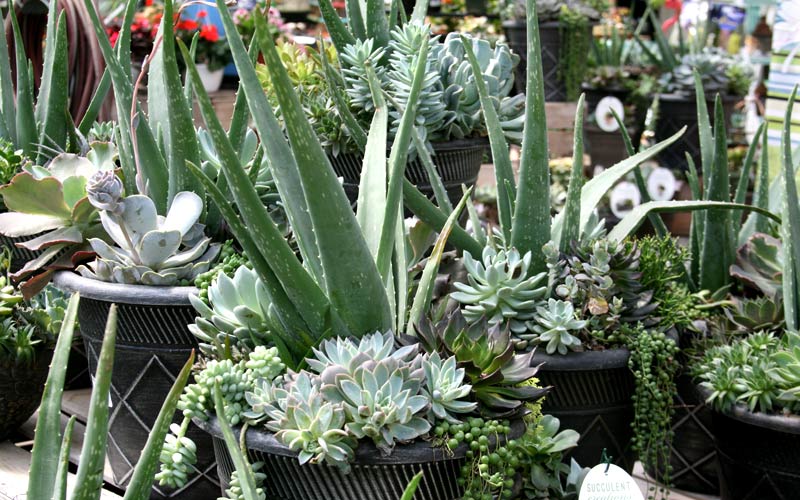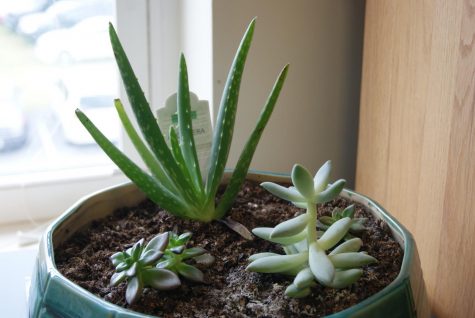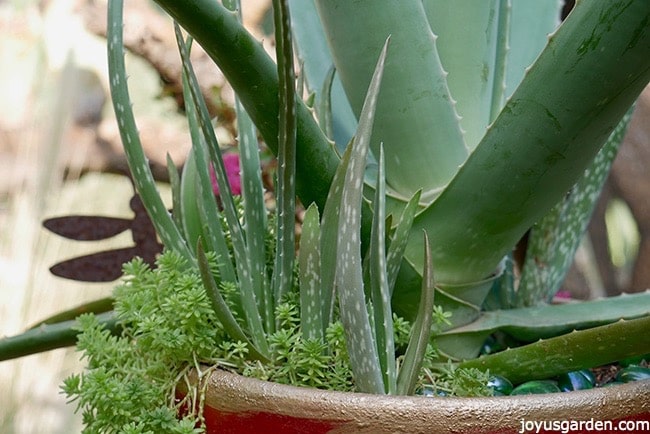
Table of Contents
Is aloe a succulent?
Yes, aloe is a low-maintenance succulent that is grown as a houseplant. The stem of an aloe succulent is extremely short, and the entire plant produces thick, prickly leaves. Aloe vera is a succulent because it can survive in a variety of climates and doesn’t require a lot of light or water. Aloe vera meets all the requirements to be classified as a succulent.
So the aloe plant is a succulent, and it developed the ability to grow in desert regions where water is scarce long ago. It learned how to store water in its leaves and only use it when necessary. This technique undoubtedly makes the aloe plant a slow-growing succulent, but at least it survives in harsh environments where most plants perish.
If you own a succulent, you probably already know that aloe will continue to grow without water for a few weeks before someone offers it any. It won’t perish in two weeks, but giving it water and plenty of light will encourage the aloe vera foliage to develop more.
Many people are drawn to aloe succulents because they are common indoor plants with medical benefits for treating skin conditions and the ability to keep a place in a house for a view. Aloe succulent leaves are utilized for a variety of skin-related issues, including burns, dry skin, and more.
Aloe succulents can withstand light exposure ranging from partial to full, although intense sunshine can burn the leaves. Additionally, you must boost watering at such time to prevent complete drying.
The bunny ear succulent, also known as the rabbit succulent, is a new succulent that has recently entered the market. You may have heard of other succulents that you have never purchased, such as the string of dolphins, string of hearts, and string of bananas.
Here are some pointers for growing succulent aloe:
One) Watering
For those who grow aloe succulents indoors, regular watering is not necessary because they receive indirect light every day and don’t require it.
Depending on how many hours of direct sunlight your aloe vera receives each day, you should water your plants every 5 to 10 days if you are growing them outdoors or indoors near south-facing windows.
I advise you to just water when the top soil appears dry. If you place an aloe succulent in direct sunlight, it may require watering every two to three days because the soil there dries up quickly. You may also notice symptoms like sunburnt leaves, leaf blotches, or leaves that are turning brown or drooping.
Giving it less water and growing in partial sunshine will work.
2. The Need for Light
Aloe succulents can grow in full sunlight, partly sunlight, and shade, but they often prefer shade and brief periods of sunlight. It’s possible that the morning sun is what protects the plant leaves. Aloe succulents perform best with shadows, but some people with south-facing windows may get a few hours of sun.
When grown outdoors, a succulent needs a location that will provide it with 2-3 hours of sun and then shade. Some trees may offer this, but others may block out all but a few hours of sunlight with their branches and leaves.
Direct sunshine can help aloe succulents develop, but it can also harm the leaf margins and even burn them if the light is too strong.
Aloe succulents are attractive, therefore in order to preserve their attractiveness, you should give them adequate partial sunshine; nevertheless, if you want the plant to grow more quickly, sunlight is the ideal source. You might need water frequently, and too much sun is still a problem.
3. Soil
Your aloe succulent will grow faster and more healthily if you use potting soil for succulents and cacti. It does increase aeration, drainage, and all types of nutrients necessary for the plant’s growth.
It may not be obvious when using bad soil for aloe succulents at first, but once root rot and fungal infection occur, it is obvious that we should use good soil that is well-drained and rich.
Aloe succulents require rich soil with excellent drainage. We want the water to drain and not pool since doing so causes fungal disease in the roots.
The 2:2:1 ratio, which consists of 2 parts sand and gardening soil with 1 part of either pumice or perlite, worked well for me in creating the ideal potting mixture for aloe succulents. Additionally, you can combine commercially available succulent potting mix to add more fertilizer to the soil. You may also add 1 part of that potting mixture.
There is no need to add more potting soil if you use fertilizer for succulents because it has the same effect. Adding gravel can help improve drainage and possibly give the roots of the aloe succulent air in the soil.
3. Toxicology
Dogs and cats are harmful to aloe succulents, so you should put the plant in a spot where your pet doesn’t stay for long. According to the ASPCA, the aloe succulent contains a gel inside its leaf that is edible and used to cure skin issues, but the outside of the plant is poisonous and may upset the stomach, causing vomiting and diarrhea.
Aloe succulents have a moderate amount of toxicity, making them neither very dangerous nor entirely harmless. Once the aloe plant has been consumed, various symptoms, such as anorexia, depression, and a change in urine, indicate that something is not right.
5. Thermostat
Aloe succulents can be grown in perfect room temperature settings. Since this plant dislikes bitterly cold days, you shouldn’t leave it outside throughout the winter. The plant might be protected from the frost by being given warm temperatures in the winter.
We don’t typically measure these things when cultivating aloe plants, despite the fact that a succulent like aloe may grow between 65 and 80 degrees F and is a growing plant. Aloe vera doesn’t require much because it can adapt to adverse conditions.
The majority of plant-based businesses are now employing people to cultivate these in a huge agricultural field and take use of it in ayurveda since they are so attractive and advantageous. If you’ve ever used these products, they do produce good effects.
Regarding aloe vera
| Family | Asphodelaceae |
| Scientific Name | Aloe barbadensis miller |
| Native | Arabian Peninsula |
| Other Names | Cape aloe,Aloe plant, Chinese aloe, Barbados Aloe |
| Plant Type | Perennial, Succulent |
| Hardiness zone | 4a to 8b |
| Grown | Pots, Containers, Gardens, |
| Height | 24-40 inches(50-101cm) |
| Growth rate | Slower |
| Soil | Well draining, Fertile |
| Light Requirement | Partial Sunlight, Full Sun(Can Tolerate) |
| Fertilizer | Liquid based |
| USDA hardiness | Zone 8 – 11 |
| Blooming Season | Summer |
| Flower Color | Orange, Red, Yellow |
| Leaf Color | Green, Spiky Shape |
| Growth Rate | Slow growing |
| Benefits | For Skin and Body |
| Uses | Cosmetics, skin creams |
| Toxicity | Mild toxic |
kinds of aloe vera
I’m only identifying the more well-known of the 400 or so species of aloe vera.
- Maculata Aloe
- Alocasia broomii
- A. F. rox
- The aloe plant
- Perry’s Aloe
- Nyeriensis aloe
- Succotrin Aloe
- such as Aloe Capitata

Are succulents and aloe the same thing?
Aloe vera plants are succulent plants, hence the terms succulent and aloe are interchangeable. Succulents require little maintenance and can even go over long periods of time without water. Cactus and the succulent itself are used to make the potting soil that succulents utilize. The plant may flourish in poor soil, but if the drainage of the poor soil is compromised, how can it survive? I’ve observed folks utilizing poor soil, which can cause plant root rot.
Aloe is a succulent that resembles a cactus in that it can grow in moist environments and has prickly leaves. Since our aloe plant doesn’t require daily watering and can survive for weeks without it, it is similar to succulents, which need less water overall. If the owner of an indoor aloe succulent is gone for a few days or weeks, the plant can survive longer and keep water on its leaves. Its ability to survive and continue to develop slowly is what distinguishes it as a succulent plant.
Does aloe need succulent soil?
Aloe does not absolutely require succulent soil, but for its darker, healthier leaves, it can thrive in a potting mixture that contains both cacti and succulents. To create an aloe’s natural succulent potting mix, use 2 cups of coarse sand, 2 cups of garden soil, and 1 cup of pumice or perlite for greater drainage.

Miracle-GRO succulent mix and Hoffman’s cactus and succulent blend, both of which are readily available in the market, are the best suggested soils for aloe succulents. You can choose from 4 to 10 Quart packs, depending on your needs. In addition to peat moss, limestone, and reed sedge peat, Hoffman soil also contains perlite. These additional elements improve the soil’s drainage, allowing plants to absorb all the water they require while allowing any extra to be drained away.
Is aloe a cactus?
No Aloe is a succulent, yet it has thick leaves and thorns on the sides, giving it the appearance of a cactus. Both cacti and aloe vera are succulent plants that thrive in arid environments and can withstand heat, allowing them to grow in higher USDA zones. Aloe is a member of the Liliaceae family, while cacti are members of the Cactaceae family, which includes over 126 different species.
Due to its prickly leaves and tendency to grow in arid climates, cacti were once mistakenly referred to as succulents. While succulents like aloe are mostly employed for medical uses and internal decoration, cacti are used as fodder or for outdoor ornamentation.
Planting aloe with other succulents
Aloe and other succulents can be grown together because they both need the same kind of soil. Because the aloe plant is a succulent and some people mistakenly call it a cactus, the watering requirements for aloe and other succulents are also the same. These plants just grow nicely in plain pots without much fertilizer, but if you want your aloe to have strong leaves and vibrant greenery, fertilizer could offer it that.
Aloe typically grows alongside other succulents because the light requirements for succulents are quite low. However, a cactus may be exposed to sunlight over extended periods of time without suffering any harm, whereas aloe and other succulents may get leaf burns.
